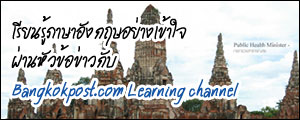Sacred sight

SW visits a popular pagoda
By Itsarin Tisantia
The Phra Maha Chedi Chai Mongkhon pagoda, located in Hnong Pok district of Roi Et province, was founded by renowned local monk Luang Phu Sri Maha Viro. The magnificent six-storey pagoda was designed by the Fine Arts Department and is located in a 101 rai area of land.
Student Weekly recently went to explore this beautiful and sacred landmark.
Buddhists pour water on a Buddha statute in front of the central pagoda. The top part of this pagoda was made with more than 60 kilogrammes of gold. |
 |
 |
The Sema Dhammachak, a Buddhist boundary marker and the wheel of the Dhamma, is situated next to the pagoda. In Thailand, it has been used as the official symbols of both Buddhism and the Ministry of Education. |
 |
Hundreds of Buddha images are neatly housed along the wall surrounding the pagoda. |
 |
Walls and mirrors inside the pagoda are painted with images from Buddhist stories and classic Thai literature. |
A statute of pagoda founder Luang Phu Sri Maha Viro stands inside the first floor of the pagoda. |
 |
|
The sun shines through luk nimit, a symbolic stone used to mark Buddhist structures, in front of the pagoda. |
 |
Among the many shops and boats along the long canal, a woman cooks the local dessert tong muan sod (fresh rolled wafers), which is flavoured with pandan leaves. |
 |
A couple admires the view from the fifth floor of the pagoda. |
Phra Maha Chedi Chai Mongkhon is open daily from 6.00 am to 5 pm. Admission is free. For more information, call 043 527 117 or 043 515 374.
EXERCISES
Read through Freeze Frame. Then, answer the following reading comprehension questions.
1. Who is the pagoda founder?
2. What time does the pagoda close in the evening?
3. Sixty kilogrammes of silver were used for the top of the central pagoda. True or false?
4. From which floor of the pagoda can you see a view of the surrounding countryside?
Vocabulary
pagoda (n): a temple in Asia in the form of a tall tower with several levels
magnificent (adj): extremely attractive and impressive
landmark (n): a building or place that is important because of its history, and that should be preserved
boundary (n): a real or imagined line that marks the limits or edges of something and separates it from other places or things
marker (v): an object or sign that shows the position of something




